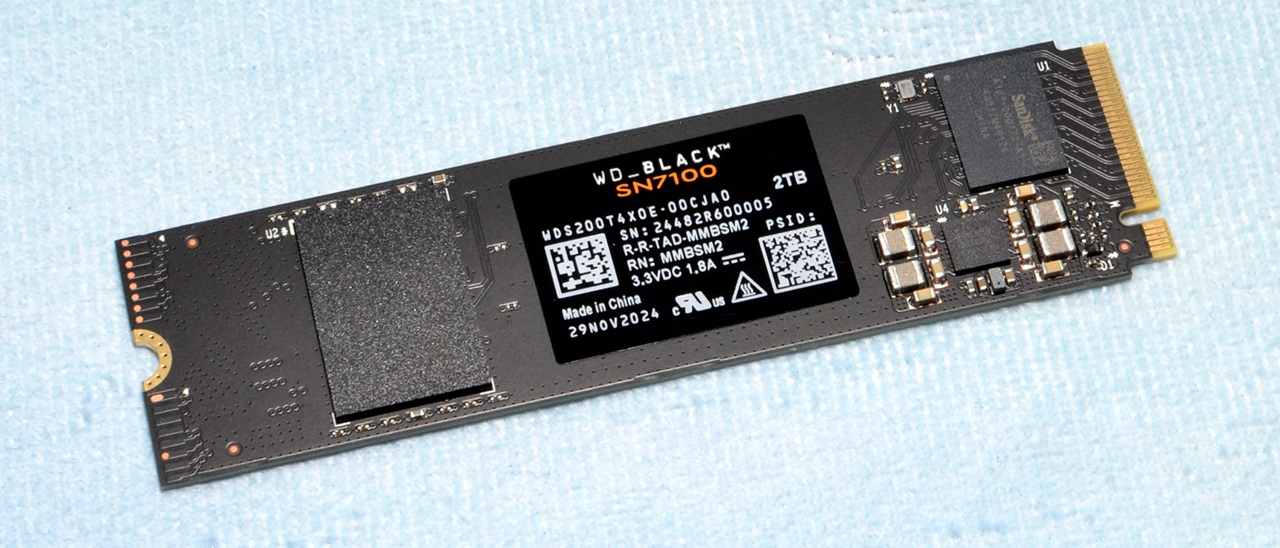Tom's Hardware Verdict
The WD Black SN7100 is a competent drive and the successor to the popular SN770, but it’s largely unimpressive aside from its chart-topping power efficiency.
Pros
- +
Extremely efficient
- +
Excellent random read performance
Cons
- -
Mediocre all-around performance
- -
No 4TB option at launch
- -
Current pricing higher than SN850X
Why you can trust Tom's Hardware
The new power efficiency champion is here. WD’s Black SN7100 NVMe SSD sets a new benchmark with its low power consumption, and its random read performance is also similarly surprising. All of that comes at a price, both literally and in the form of lower all-around performance. Is it a worthwhile tradeoff, and how does it stack up to the best SSDs?
The update to WD’s popular Black SN770, a drive we loved back when we reviewed it, is finally here. If it feels like too little, too late, it would be because it trails even the late-arriving Samsung 990 EVO Plus, another excellent laptop drive from a company that designs its own controller and flash. WD’s use of a proprietary controller and the newest 218-Layer BiCS8 flash is something that falls into the SN7100’s plus column as it makes for consistent hardware and usually a reliable platform. This sounds like an easy win for laptops users, HTPC builders, PS5 owners, and could be a great upgrade for portable gaming systems that can take or be modified to take M.2 2280 SSDs.
That recommendation comes with some caveats, however. The SN7100 is only available in capacities up to 2TB right now, which is plenty for most people, but 4TB is a notable omission as we’ve had plenty of excellent budget drives available at the latter capacity like the Lexar Play. We can overlook this limitation as the SN7100 is single-sided with only one NAND flash package — you’d need two for 4TB, which would rule out M.2 2230 for any OEM version — but it's more difficult to see past the drive’s current pricing.
Comparative drives can be had for 10% less at 1TB and 2TB, though the drive may be compelling at 500GB and the price tradeoff might be worth it for where the SN7100 shines. It’s not enough to achieve our highest accolades, but there’s definitely something here for the right buyer.
WD Black SN7100 Specifications
Product | 500GB | 1TB | 2TB |
|---|---|---|---|
Pricing | $54.99 | $84.99 | $139.99 |
Form Factor | M.2 2280 | M.2 2280 | M.2 2280 |
Interface / Protocol | PCIe 4.0 x4 / NVMe 1.4 | PCIe 4.0 x4 / NVMe 1.4 | PCIe 4.0 x4 / NVMe 1.4 |
Controller | Polaris 3 (Proprietary) | Polaris 3 (Proprietary) | Polaris 3 (Proprietary) |
DRAM | N/A (HMB) | N/A (HMB) | N/A (HMB) |
Flash Memory | Sandisk 218-Layer TLC (BiCS8) | Sandisk 218-Layer TLC (BiCS8) | Sandisk 218-Layer TLC (BiCS8) |
Sequential Read | 6,800 MB/s | 7,250 MB/s | 7,250 MB/s |
Sequential Write | 5,800 MB/s | 6,900 MB/s | 6,900 MB/s |
Random Read | 760K | 1,000K | 1,000K |
Random Write | 1,200K | 1,400K | 1,400K |
Security | N/A | Row 10 - Cell 2 | Row 10 - Cell 3 |
Endurance (TBW) | 300TB | 600TB | 1,200TB |
Part Number | WDS500G4X0E | WDS100T4X0E | WDS200T4X0E |
Warranty | 5-Year | Row 13 - Cell 2 | Row 13 - Cell 3 |
At launch the WD Black SN7100 has a smaller capacity range than the Black SN770, ditching the smallest 250GB SKU with 500GB, 1TB, and 2TB availability. Pricing is at $54.99, $84.98, and $139.99 at the time of review, respectively. Some of these prices went up during writing, which reflects the difficult nature of judging SSD pricing, and it's an ongoing problem for many months now.
Notably absent is a 4TB model, which is worthy of a demerit as there have been plenty of solid drives in this class with an affordable 4TB option going back at least 18 months. Lexar’s NM790 is a good example of a good budget 4TB drive. It does seem like a 4TB SKU is in WD’s plans, but we’ll have to see pricing and availability to make any calls on that. WD’s move away from its smallest capacity makes sense as flash is getting denser and there is a higher performance penalty for running with fewer flash dies.
This means the drive still has pretty good performance at its smallest capacity, which holds twice as much as its predecessor. The SN7100 reaches maximum performance at 1TB, and holds steady at 2TB. Officially, the drive can hit 7,250 / 6,900 MB/s for sequential reads and writes and up to 1,000K / 1,400K random read and write IOPS. There was a time when this level of performance seemed out of reach, but now you can get it on a budget drive with no compromises made for power draw. WD backs the Black SN7100 with a 5-year warranty and the standard 600TB of writes per TB capacity.
WD Black SN7100 Software and Accessories
Western Digital, or SanDisk if you prefer, does a pretty good job of supporting its SSDs with capable software. While Samsung is the gold standard here with its Magician software, WD’s Digital Dashboard is a strong rival. This Windows application is a great way to manage your SSDs with access to health information, drive features, firmware updates, and more.
WD also offers an OEM version of Acronis True Image for both Windows and macOS. When you get a new drive you can use this to back up files and image or clone the old drive, which is handy. Strictly speaking, software support is not a requirement for SSDs, but if you expect that level of interaction then WD is always a good choice.
WD Black SN7100: A Closer Look

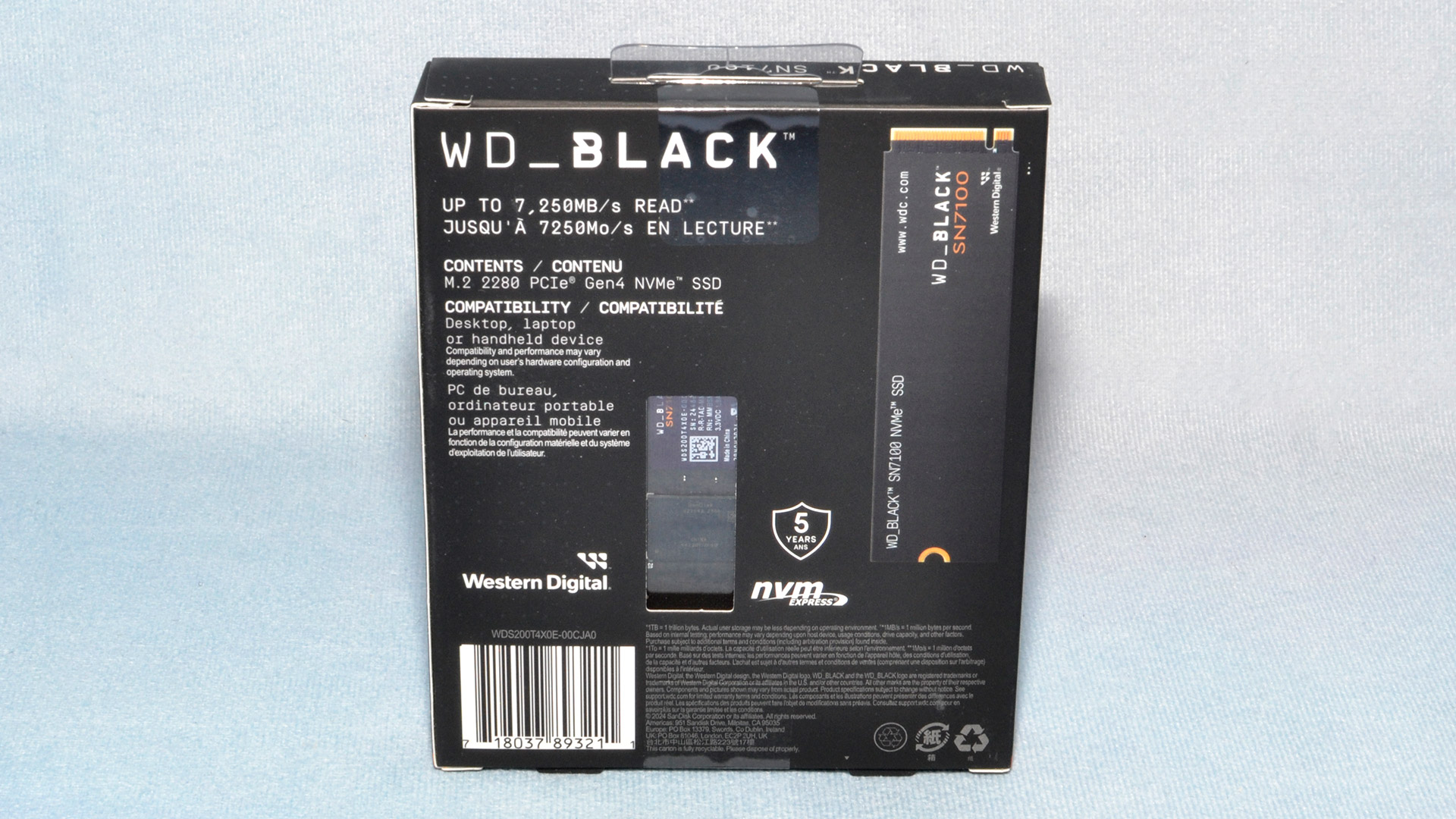
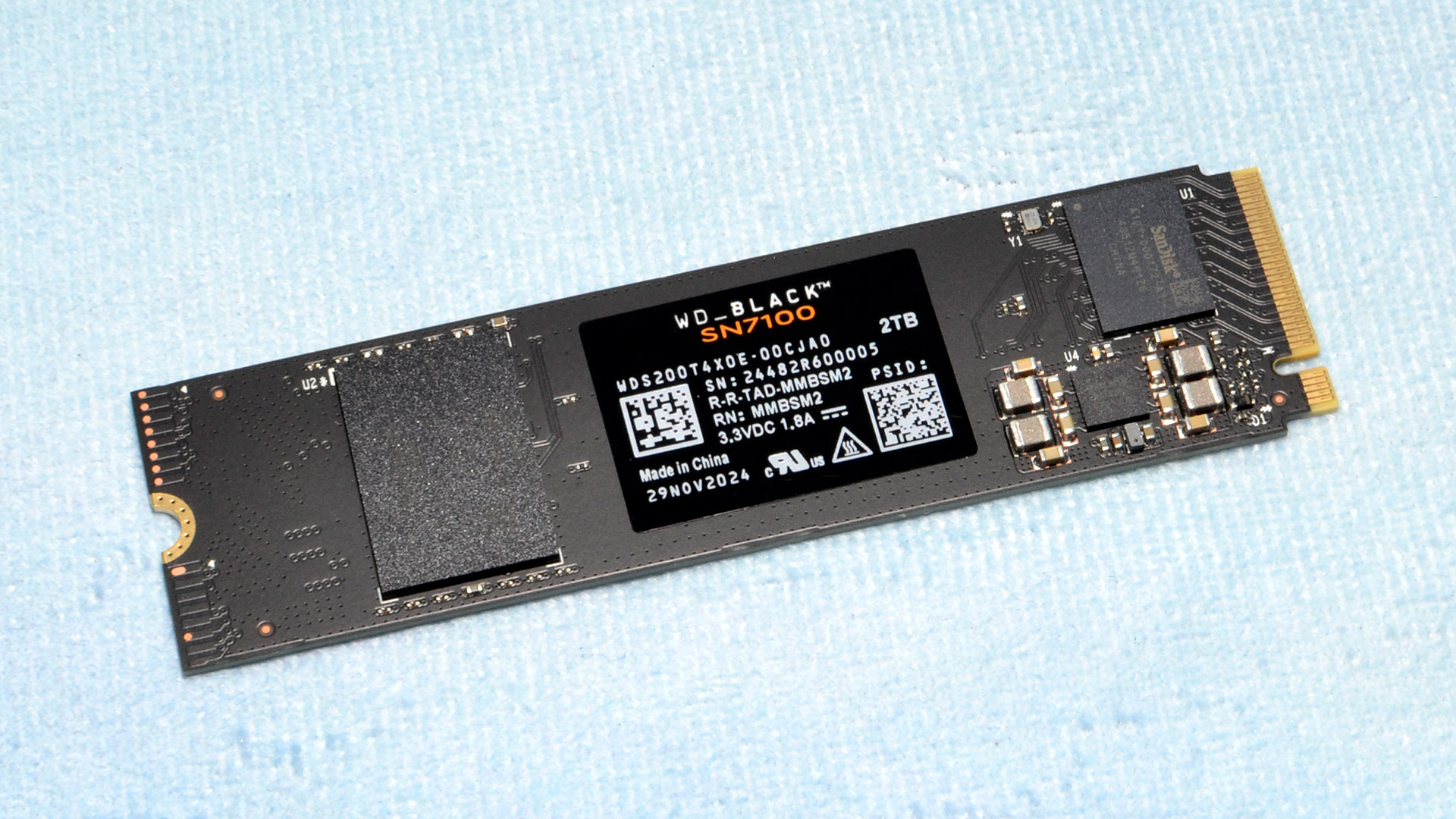
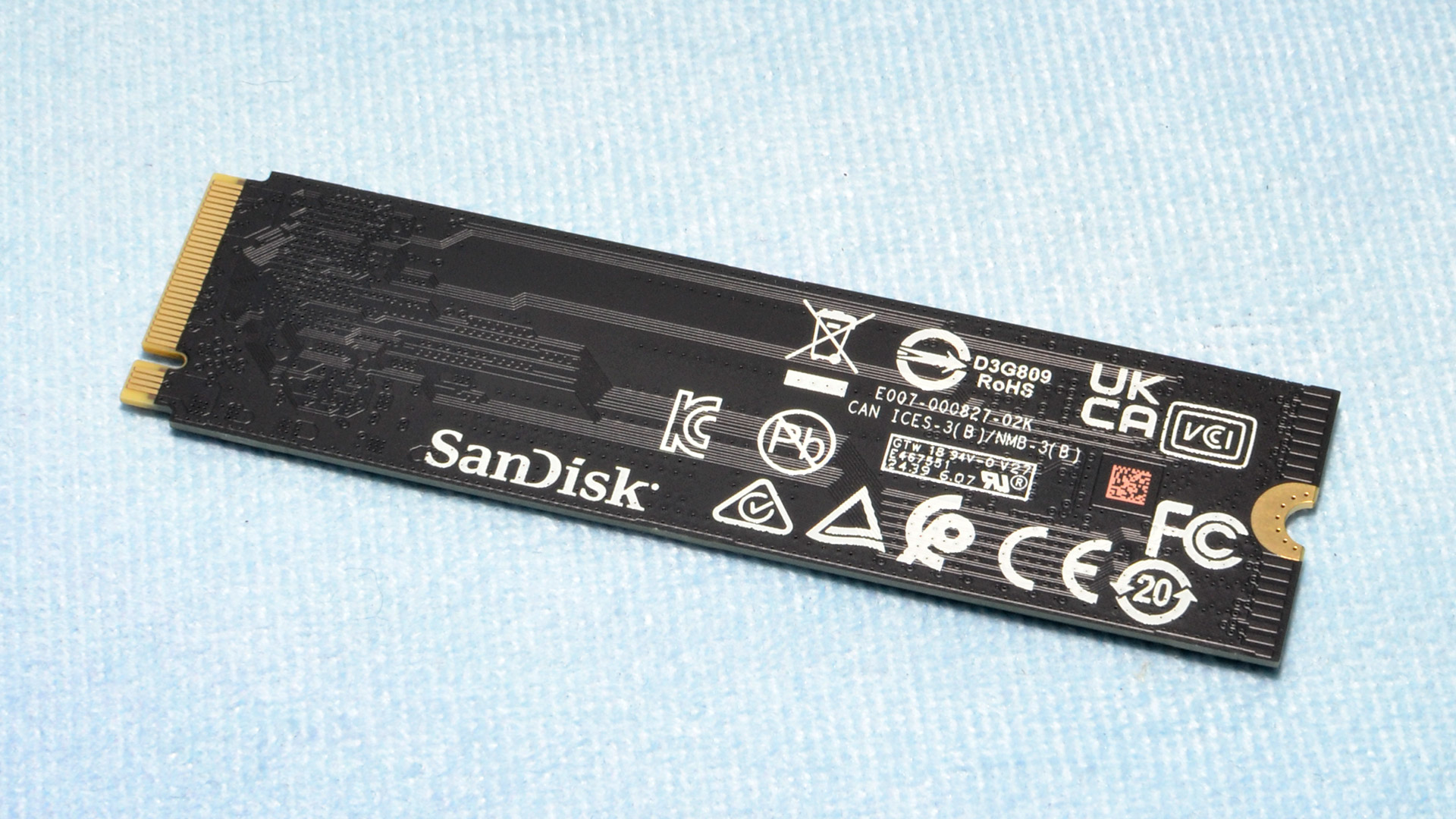
The 2TB Black SN7100 is single-sided with a controller, no DRAM, a power management chip, and a single NAND flash package. This layout makes the drive very usable in laptops and other portable or embedded devices that can take M.2 2280 SSDs. WD also has the space to run this in shorter form factors for OEM. As this TLC flash uses 1Tb dies, there are sixteen dies in the package to reach 2TB. WD would have to run two packages for 4TB, which is quite doable but the current layout is potentially more efficient from a production standpoint.
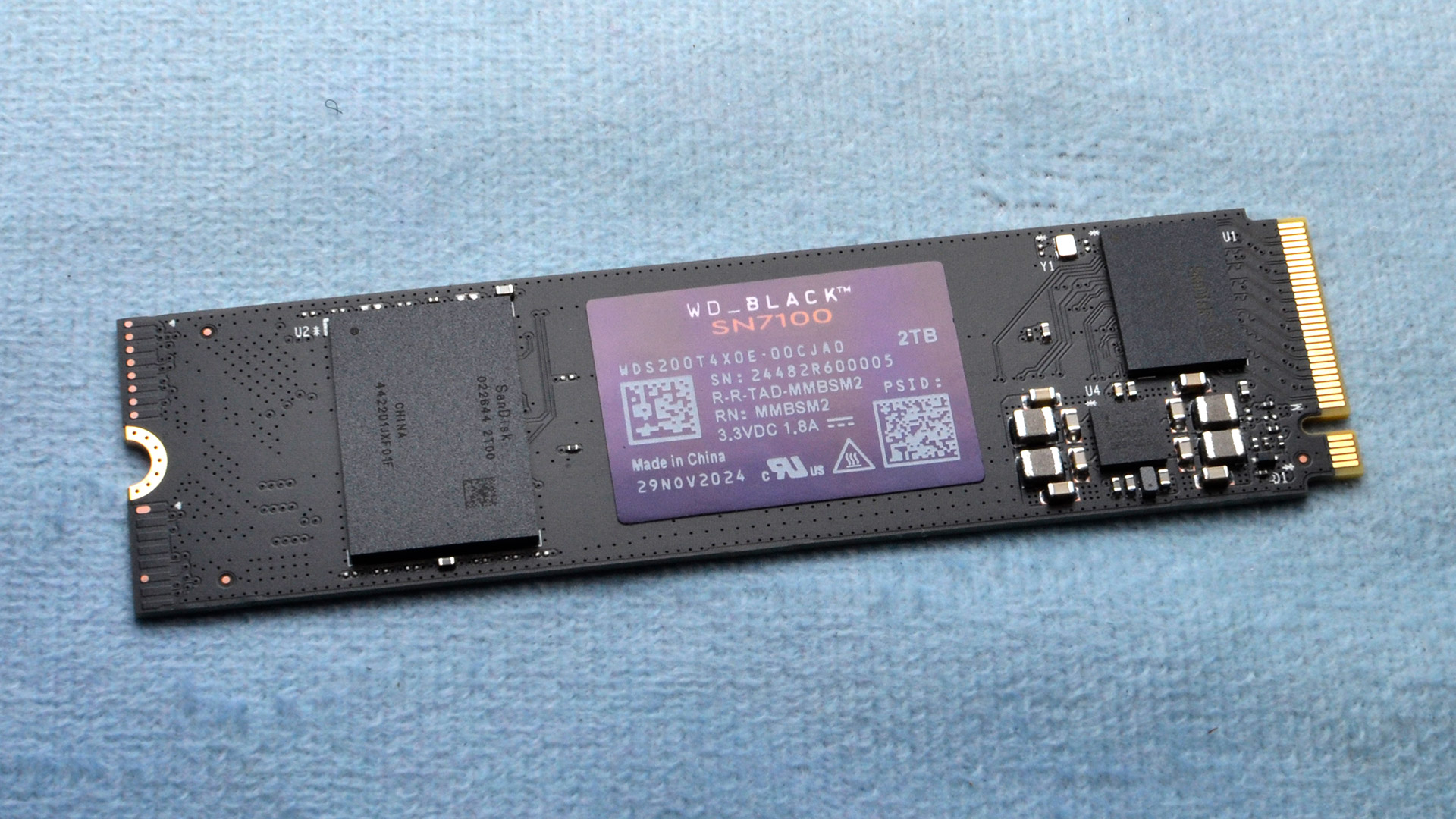
We’ve already taken a look at Sandisk’s 218-Layer BiCS8 TLC flash (formerly called Kioxia BiCS8) in our Corsair MP700 Elite review, where it shined, but let’s talk about the controller. SanDisk’s Polaris 3 is an iterative improvement over past Polaris silicon that’s been used in many drives, including the Blue SN580. Generally speaking, we’ve seen optimizations here and there from WD, certainly in firmware, but the main change over time has been the bus rate. Increasing the bus rate allows the use of newer flash and brings the ability to maximize throughput with fewer channels and dies.
One way to look at the SN7100 is as a faster SN770, SN580, Blue SN570, or another drive that uses effectively the same controller. Theoretically, WD could have gotten away with using 162-Layer BiCS6 on this drive, the flash we’ve seen on many drives such as the Blue SN5000. BiCS6 can match the 2,400 MT/s rate of the Polaris 3 while BiCS8 can hit up to 3,600 MT/s. Previously, we’ve seen that speed with the Corsair MP700 Elite, which needs the extra bandwidth for its PCIe 5.0 interface. So why did WD go with BiCS8 here?
There are multiple possible reasons. One is that BiCS8 is more efficient than BiCS6 as the former uses an improved circuit under array (CuA) design with a CMOS bonded array, a wafer-on-wafer type approach somewhat similar to YMTC’s Xtacking. This approach can also help ramp up production faster, and the move to higher layer count flash is a natural progression for better pricing per gigabyte.
BiCS8 is also faster than BiCS6 in terms of both random read performance and total write throughput. This can improve performance for even the smallest 500GB SKU and in general helps WD compete favorably with drives like the Corsair MP600 Elite.
MORE: Best SSDs
MORE: Best External SSDs
Get Tom's Hardware's best news and in-depth reviews, straight to your inbox.
MORE: Best SSD for the Steam Deck

Shane Downing is a Freelance Reviewer for Tom’s Hardware US, covering consumer storage hardware.
-
usertests Typo: 1,2000KReply
No 4TB option at launch
Off-topic: Will we see intermediate capacities like 12 TB take off instead of going straight from 8 to 16? -
Notton WD is still making new SSDs? I thought they split off their SSDs into Sandisk?Reply
I guess it's good they are still making new products, but the SN770 was plenty fast and efficient for laptops. -
JarredWaltonGPU Reply
Fixed, thanks!usertests said:Typo: 1,2000K
We really ought to, as the doubling of capacities starts to break down beyond a certain level. I don't know if there's any special reason consumer SSDs have traditionally stuck to powers of two, but it seems like there shouldn't be a serious technical limitation. Sort of like how GPUs are still doing it but now we have 24Gb (3GB) GDDR7 chips...usertests said:Off-topic: Will we see intermediate capacities like 12 TB take off instead of going straight from 8 to 16?
Yeah, the SanDisk / WD thing is a bit weird. I guess the WD Black branding is stronger, so we're likely to still see new WD branded SSDs. I'm not sure that's 100% correct, but obviously the SN7100 got WD branding.Notton said:WD is still making new SSDs? I thought they split off their SSDs into Sandisk?
I guess it's good they are still making new products, but the SN770 was plenty fast and efficient for laptops. -
HideOut It's a little odd. They're spending this division off to SanDisk and this is basically out of date already. I mean it's Gen 4 and doesn't go any higher than 2 TB. I mean that was decent 3 to 4 years ago maybe.Reply
Someone here posted about the 24 GB video cards so we should see intermediate capacities of ssds like 12 gigs but that's two different things. 24 GB memory capacities on video cards have to do with the memory bus with. 128-bit with and 256 have the even numbers like 8 or 16 or 32. If itt has a 356-bit bus. It can have the 11/14/36 etc. there are new types of memory that are 3 gig per chip instead of two coming. And that may allow us hopefully to get what you're asking for. I know that video cards are going to start to see it possibly soon -
SyCoREAPER All relevant. Temperatures play a big part in choosing a drive based on the application.Reply
I'd take the SK Hynix Platinum P41 at 0.16 watts higher slightly lower performance and virtually or at least comparatively cooler temps to similar drives I tested. -
Notton Reply
Gen4 is still relevant, especially if it's power efficient, runs cool, and cost effective.HideOut said:I mean it's Gen 4 and doesn't go any higher than 2 TB. I mean that was decent 3 to 4 years ago maybe.
Most people aren't going to notice the difference between Gen4 vs. Gen5, even in games.
I'm sure they'll release a 4TB later on, as they did that with the SN5000. -
Frozoken Reply
Lol basically out of date?? Have you seen its random read latency? That matters 100x more than being pcie gen 5 direct storage has just proven even further that sequential speeds will never matter more than random read speeds in the remotely near future. It causes more problems than it solves in 90% of games with itHideOut said:It's a little odd. They're spending this division off to SanDisk and this is basically out of date already. I mean it's Gen 4 and doesn't go any higher than 2 TB. I mean that was decent 3 to 4 years ago maybe.
Someone here posted about the 24 GB video cards so we should see intermediate capacities of ssds like 12 gigs but that's two different things. 24 GB memory capacities on video cards have to do with the memory bus with. 128-bit with and 256 have the even numbers like 8 or 16 or 32. If itt has a 356-bit bus. It can have the 11/14/36 etc. there are new types of memory that are 3 gig per chip instead of two coming. And that may allow us hopefully to get what you're asking for. I know that video cards are going to start to see it possibly soon -
Mindstab Thrull Replyusertests said:Off-topic: Will we see intermediate capacities like 12 TB take off instead of going straight from 8 to 16?
I will simply point out that for hard disk drives, capacities of 3, 6, and 12TB exist, and RAM is now coming in 24 and 48GB sticks. So I think it's very likely that 12 and 24TB capacities will come out.
Mindstab Thrull
Nomming ur sanities since 1863 BSE (before the Sarpadian Empires) -
dc443 Alright so this drive is currently the value king at $210 for 4TB. I feel like it probably would change the review to 5 stars by this point as all of the concerns (value and 4tb capacity option) have been addressed. I was taking a look at 8TB M.2 options but this is just a much more reasonable item to purchase.Reply
With a 2400tbw endurance rating I will be hard pressed to find a better choice now for a high speed bang for the buck drive in mid 2025, especially when this one is comparatively low power and dispensing with the DRAM which looks like is totally unnecessary as the flash can absorb 4x gen 4 speeds for quite a ways on its own.
I would pick one up right now if i needed more but looks like i don't actually need it now and i dont expect nand prices to shoot back up again. that sucked last time that happened. -
JarredWaltonGPU Reply
Performance is modest, at best. A PCIe 4.0 drive, released in early 2025, just isn't that impressive. What's more, it consistently trails behind a lot of other PCIe 4.0 drives. It's unimpressive, and while being less expensive than some other drives helps, it doesn't fully rectify the situation — especially when the price difference in many cases isn't all that large.dc443 said:Alright so this drive is currently the value king at $210 for 4TB. I feel like it probably would change the review to 5 stars by this point as all of the concerns (value and 4tb capacity option) have been addressed. I was taking a look at 8TB M.2 options but this is just a much more reasonable item to purchase.
With a 2400tbw endurance rating I will be hard pressed to find a better choice now for a high speed bang for the buck drive in mid 2025, especially when this one is comparatively low power and dispensing with the DRAM which looks like is totally unnecessary as the flash can absorb 4x gen 4 speeds for quite a ways on its own.
I would pick one up right now if i needed more but looks like i don't actually need it now and i dont expect nand prices to shoot back up again. that sucked last time that happened.
If you can find a Maxio MAP1602 drive with YMTC TLC NAND, that's generally faster than the SN7100. It's just not as power efficient, so that's not great for laptops. I'd basically call it a wash, depending on how you're planning to use the drive.
One of the irritating things is that SSD's have gone up in price, and a lot of the "better" budget drives switched from TLC to QLC NAND, which means they're no longer desirable if you can get a TLC drive for roughly the same price. But Shane wrote the review, and he's the one that gave this a 3-star rating, based on underwhelming performance and pricing.
